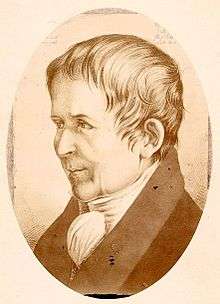Jean-Louis Pons
| Jean-Louis Pons | |
|---|---|
 Jean-Louis Pons | |
| Born |
24 December 1761 Peyre |
| Died |
14 October 1831 (aged 69) Florence |
| Nationality | French |
| Fields | Astronomy |
| Notable awards | Lalande Prize (1818) |
Jean-Louis Pons (24 December 1761 – 14 October 1831) was a French astronomer.[1] Despite humble beginnings and being self-taught, he went on to become the greatest visual comet discoverer of all time: between 1801 and 1827 Pons discovered thirty-seven comets, more than any other person in history.
Early life
Pons was born at Peyre, Hautes-Alpes, to a poor family; he received little formal education. In 1789, he began working for the Marseille observatory as a caretaker, and gradually gained some experience in assisting the astronomers with observations. He learned to make observations himself, showing a remarkable ability to remember star fields and note changes in them.
In his early astronomical career, the unassuming and trusting Pons was often the target of jokes perpetrated by more experienced astronomers. Franz Xaver von Zach once advised him to look for comets when sunspots were visible, though in doing so Zach may have inadvertently given Pons very good advice.[2]
Career as an astronomer
Pons made his first comet discovery, jointly attributed to Charles Messier, on 11 July 1801. He appears to have used telescopes and lenses of his own design; his "Grand Chercheur" ("Great Seeker") seems to have been an instrument with large aperture and short focal length, similar to a "comet seeker".[3] However, he was not an especially diligent recorder of his observations, and his notes were often extremely vague.[3]
In 1819, Pons became the director of the new observatory at Marlia near Lucca, which he left in 1825 to teach astronomy at La Specola, in Florence. Around that time he accepted the opportunity to become Director of the Florence Observatory at the request of the Grand Duke of Tuscany.[4]
He discovered five periodic comets, three of which, 7P/Pons–Winnecke, 12P/Pons–Brooks and 273P/Pons–Gambart, bear his name. One observed on 26 November 1818 was named Comet Encke (now 2P/Enke) after Johann Franz Encke, who calculated its orbit and its remarkably short period (Encke, however, continued to refer to the comet as "Pons's Comet"). Pons also co-discovered the comet formerly known as "Pons–Coggia–Winnecke–Forbes" and today known as 27P/Crommelin after Andrew Crommelin, who calculated its orbit.
Pons received the French Academy of Sciences's Lalande Prize in 1818 for his discovery of three comets in that year. He won it again in 1820 (jointly with Joseph Nicollet) for further comet discoveries at Marlia and for an unmatched third time in 1827 (jointly with Jean-Félix Adolphe Gambart) for discovering another seven comets at the Florence observatory.[4]
By 1827, Pons's eyesight had begun to fail, and he retired from observing altogether shortly before his death, on the 14th of October 1831. In his honour, a moon crater was named after him.[5]
References
 This article incorporates text from a publication now in the public domain: Chisholm, Hugh, ed. (1911). "Pons, Jean Louis". Encyclopædia Britannica. 22 (11th ed.). Cambridge University Press. p. 61.
This article incorporates text from a publication now in the public domain: Chisholm, Hugh, ed. (1911). "Pons, Jean Louis". Encyclopædia Britannica. 22 (11th ed.). Cambridge University Press. p. 61.
- ↑ McGown, Robert D. (2007). "Pons, Jean-Louis". In Hockey, Thomas; et al. Biographical dictionary of astronomers. vol. II, M-Z. Springer. p. 924.
- ↑ Calder, N. Comets: Speculation and Discovery, Courier, 1994, p.80
- 1 2 Roemer, E. Jean Louis Pons: Discoverer of Comets, San Francisco: Astronomical Society of the Pacific, 1960, p.2
- 1 2 Biographical Encyclopedia of Astronomers. p. 923.
- ↑ "The death certificate, as well as other personal pieces of information and scientific notes are preserved in the archive of the library of the Museo Galileo in Florence" (PDF).